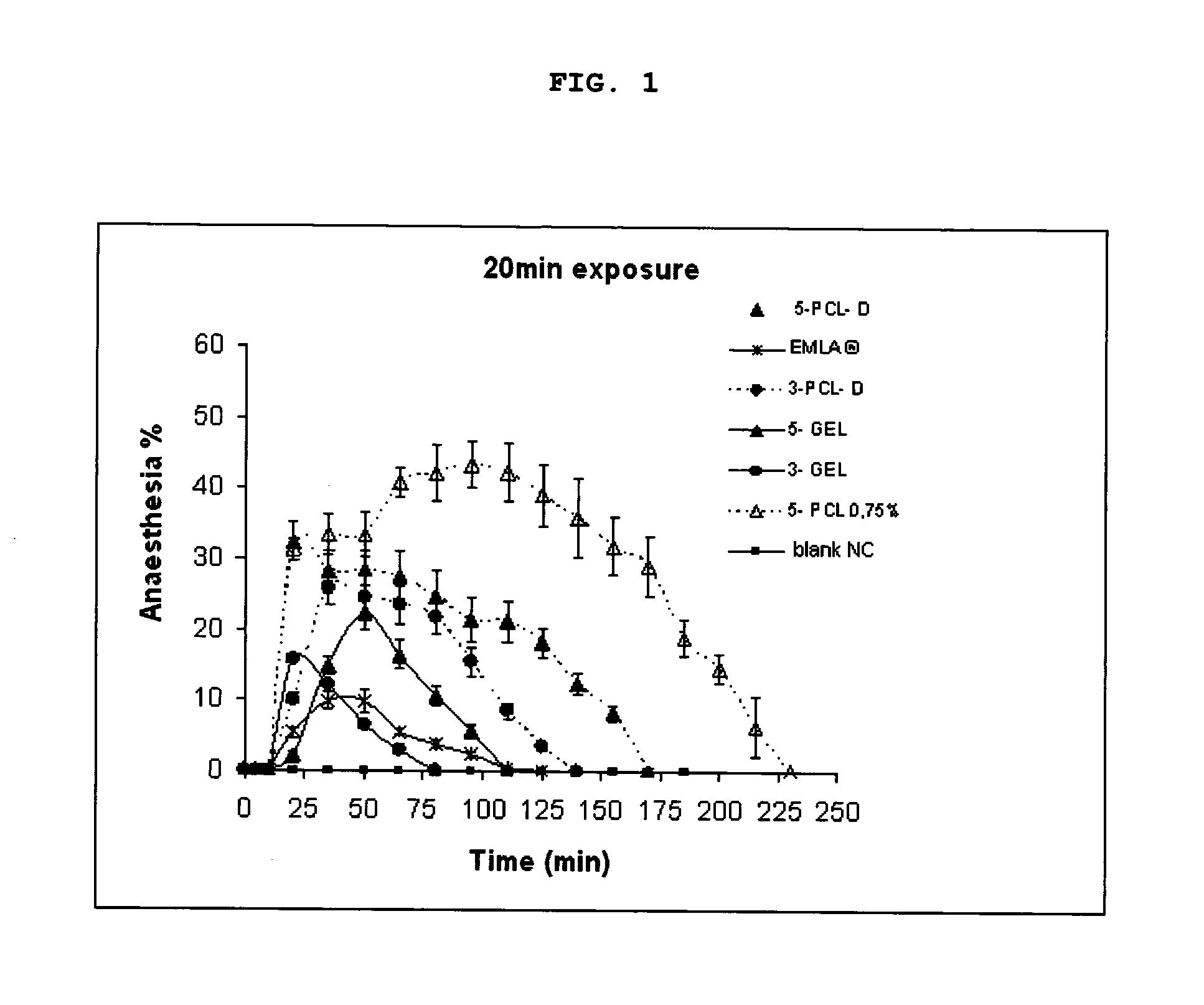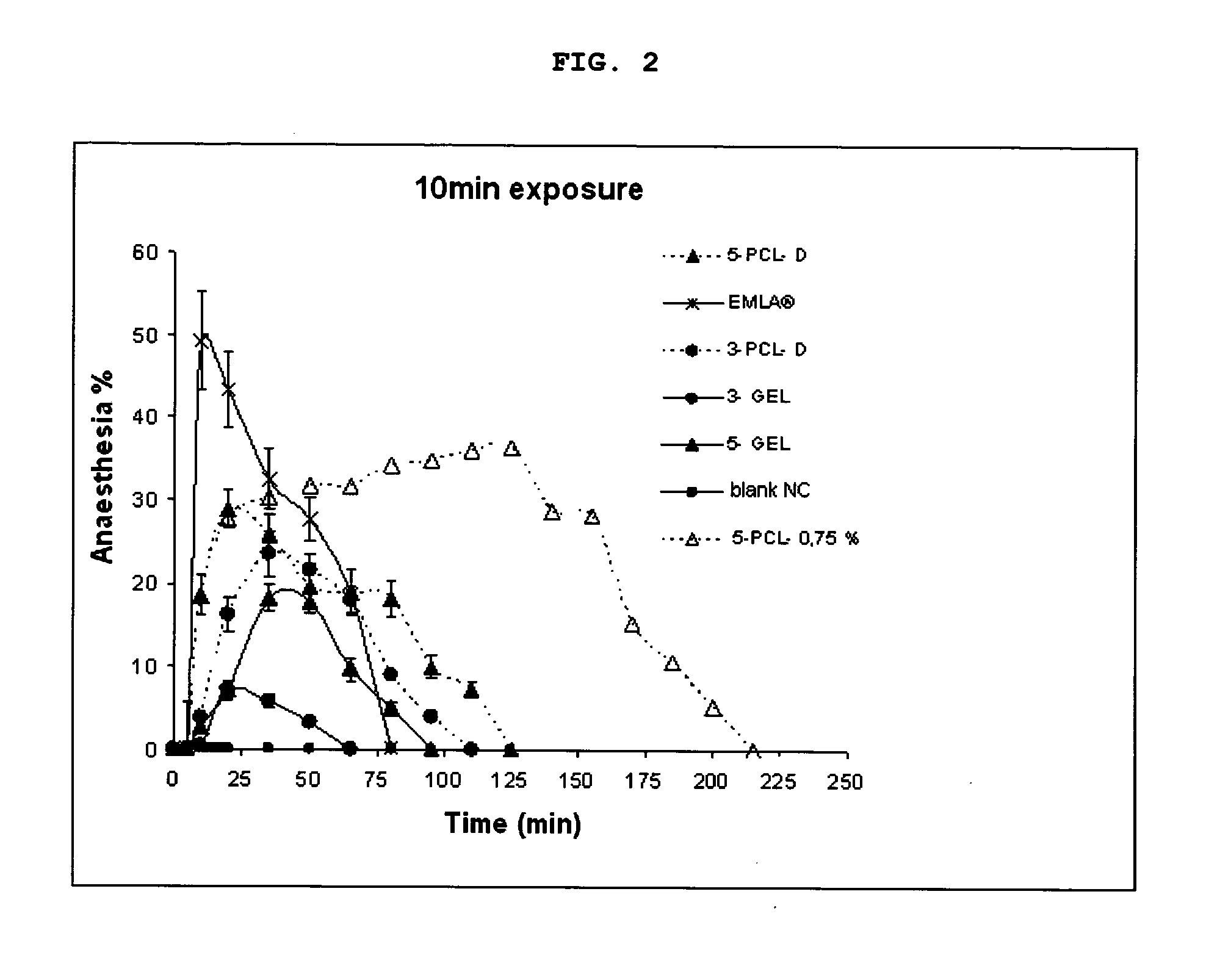Nanoparticulated anesthetic composition for topic use
a topical anesthetic and nanoparticulate technology, applied in the field of anesthetic compositions, can solve problems such as cardiac arrhythmias, local collateral effects, systemic collateral effects,
- Summary
- Abstract
- Description
- Claims
- Application Information
AI Technical Summary
Problems solved by technology
Method used
Image
Examples
example 1
Production of Anaesthetic Nanoparticles
[0030]Anaesthetic nanoparticles were prepared according to the composition of the phases presented on Table 1.
[0031]Firstly, the organic phase was prepared by dissolving the polymer (poly(ε-caprolactone), Eudragit 5100 or methyl polymethacryllate), the tensoactive (SPAN60F or Epikuron 170) and the mixture of active principles (lidocaine and prilocaine) in acetone. This phase was maintained under agitation and moderate heat (30 to 40° C.), until complete dissolution of the components. The aqueous phase was prepared in a separate beaker and consisted of the tensoactive (Tween 80) dispersed in water. After complete dissolution of the components, the organic phase was slowly poured through a funnel over the aqueous phase, under moderate agitation at ambient temperature and then maintained under agitation for a further 10 minutes. This suspension was then concentrated in a rotary evaporator at a pressure of 3-6 bar and water bath temperature of 40-4...
example 2
Preparation of the Hydrogels Containing the Suspensions of Nanocapsules and Nanoemulsions
[0037]Hydrogels were prepared by incorporating Carbopol® 940 (carboxypolymethylene), to a final concentration of 0.25%, 0.75% and 1.5% to the nanoparticle suspensions prepared in accordance with Example 1 with the final masses being adjusted through the addition of distilled water so as to obtain a final nominal rate of 5% anaesthetics for formulations G 5-PCL-TWE, G 5-PCL-TWE 0.75% and G 5-EUD-EPK (prepared, respectively, from the concentrated suspensions 5-PCL-TWE and 5-EUD-EPK, produced in accordance to Example 1) and of 3% for formulation G 3-PCL-TWE (prepared from the concentrated suspension 3-PCL-TWE produced in accordance to Example 1).
[0038]The rheological features of the semi-solid formulations were assessed through the use of a Brookfield rotational viscometer, models RV DV I+ and LV DVII+PRO, with spindle SC4-25, at speeds of 2.0 and 2.5 RPM (Table 3).
TABLE 3Viscosity of hydrogel gels...
example 3
Assessment of Anaesthetic Activity In Vivo
[0039]The in vivo percentage rate of anaesthesia promoted by hydrogels containing nanoparticles of lidocaine and prilocaine was determined in mice using the “Tail Flick” technique (Kolesnikov Y. e col. “Evaluation of the tail formalin test in mice as a new model to assess local analgesic effects”. Brain Research, v. 1029, p. 217-223, 2004) and, for comparison, the commercially available product EMLA® (a cream containing 2.5% lidocaine and 2.5% prilocaine produced by AstraZeneca do Brasil Ltda.).
[0040]The anaesthetic effect was analysed using 5 distinct groups:
[0041]Positive control group (1 group): Topical application of commercial product EMLA®.
[0042]Negative control group (1 group): Hydrogel containing nanocapsule without pharmacons.
[0043]Test groups (4 groups): Topical application of hydrogels with nanoparticles containing lidocaine and prilocaine, complying with the anaesthetic rates and nanoparticle compositions defined on Table 4.
TABLE...
PUM
| Property | Measurement | Unit |
|---|---|---|
| sizes | aaaaa | aaaaa |
| sizes | aaaaa | aaaaa |
| viscosity | aaaaa | aaaaa |
Abstract
Description
Claims
Application Information
 Login to View More
Login to View More - R&D
- Intellectual Property
- Life Sciences
- Materials
- Tech Scout
- Unparalleled Data Quality
- Higher Quality Content
- 60% Fewer Hallucinations
Browse by: Latest US Patents, China's latest patents, Technical Efficacy Thesaurus, Application Domain, Technology Topic, Popular Technical Reports.
© 2025 PatSnap. All rights reserved.Legal|Privacy policy|Modern Slavery Act Transparency Statement|Sitemap|About US| Contact US: help@patsnap.com


